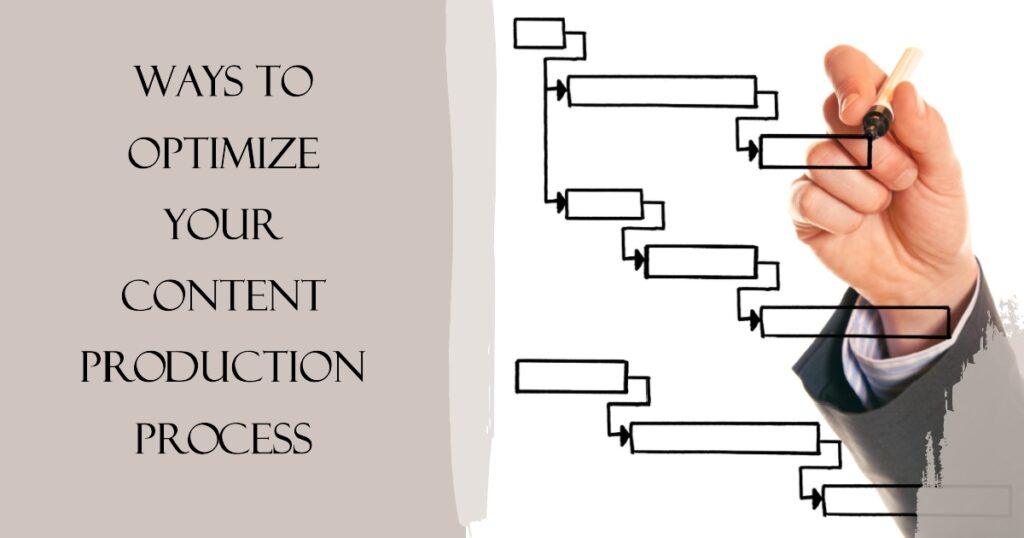Creating high-quality, engaging content consistently is crucial for companies and creators looking to grow their audience and drive results. However, the marketing content production process is complex with many moving parts. Without optimization, it can be inefficient, costly, and fail to achieve objectives.
This article will provide 13 proven methods for optimizing your content production workflow in order to boost productivity, reduce expenses, and create better content. With the right strategies in place, you can transform how your organization produces written, visual, audio and video materials to support your goals.
What is content production?

It refers to the process of creating, writing, editing, and publishing any type of content, typically for digital media purposes. This includes blog posts, articles, videos, podcasts, infographics, ebooks, and more. As content and digital media become increasingly vital for brands looking to attract and retain an online audience, understanding what constitutes it is key.
What Activities Define it?
There are several key activities that fall under the umbrella of producing content:
Research
Conducting research is an essential first step in content production planning. This may involve investigating search trends to identify topics and keywords that resonate with your target audience, exploring competitor strategies, or aggregating relevant industry data to inform and support your content. Thorough research lays the foundation for useful, engaging content.
Writing
The writing process transforms research into valuable content. Skilled writers take complex ideas and themes uncovered during research and synthesize them into compelling narratives formatted for the intended medium, be it long-form blogs, snappy social posts, or detailed guidebooks.
Editing
Careful editing polishes draft content into a refined finished product that meets quality standards. Editors review written content for elements like consistency in messaging and voice, proper grammar and spelling, logical flow, and fact-checking.
Graphic Design
While not always necessary, graphic design can greatly enhance certain types of content. Infographics, social media graphics, illustrations, photos, and other visuals make content more visually appealing and digestible for audiences. Graphic designers play a key role.
Publishing & Distribution
The final step involves publishing finished content and distributing it to the target audience through websites, social platforms, email newsletters, and other channels. Understanding best practices for optimizing and promoting content is crucial for driving engagement.
– Tools
Producing high-quality digital content requires the right content production tools:
Here are some examples of popular tools:
Writing Apps
Graphic Design
- Canva
- Adobe Creative Suite (Photoshop, Illustrator, InDesign)
- Visme
Analytics & SEO
Social Media Tools
Content Marketing Suites
– Building a Team
For larger organizations producing high volumes of content, assembling a dedicated content production team is recommended, with roles that may include:
- Content strategists
- Writers
- Editors
- Graphic designers
- Photographers/videographers
- SEO analysts
Aligning team roles to the core activities defining the content production system allows for an efficient, high-quality production cycle.
Ways To Optimize Your Content Production Process

Set Clear Goals and Targets
As with any business process, optimizing starts with having clear goals and targets to measure success towards. When launching or assessing your content efforts ask:
- What specific business objectives are we trying to achieve? Increased sales? More site traffic? Greater brand visibility?
- What types of content will allow us to meet those goals and who is our target audience? Educational articles? Entertaining social media posts? Whitepapers aimed at business leaders?
- How will we track our progress quantitatively? Website clicks? Sales qualified leads? Content downloads? Social media engagement?
Setting precise goals and performance indicators provides focus and allows you to allocate sufficient resources to content that drives results. It also facilitates optimization later on.
Understand Your Audience Insights
The strategy should stem directly from an in-depth understanding of your target buyer and what resonates with them. The more insight you have into audience challenges, interests, consumption habits and motivations for engaging with content, the better positioned you will be to create useful and compelling materials on an ongoing basis.
Prioritize conducting thorough audience research through:
- Interviews: Sit down with current customers and users to explore why they initially engaged with your company, what content proved valuable, burning questions they still have etc.
- Surveys: Distributed to current prospects and customers to gain quantitative insights into preferences.
- Analytics Review: Identify top performing content by clicks, time on page, shares etc. Examine user journeys preceding purchases or subscriptions.
- Market Research: Secondary research into your industry can include reviewing reports, monitoring relevant community discussions etc. to understand pain points and knowledge gaps.
Continuously capture intelligence over time to always be distributing content that resonates.
Audit Existing Content Assets
Take time to categorize and review all existing raw content assets – not just published materials currently visible to your audience. This includes:
- Published blog posts, eBooks, whitepapers, case studies etc. on your site or distributed via email nurturing campaigns.
- Written or multimedia materials currently in ideation or production phases.
- Archived or older content.
Critically evaluate materials while asking key optimization questions:
- How does each piece align to overarching goals and audience needs? Should some be discontinued moving forward if not driving results?
- Is content structured and effectively formatted based on medium for optimal consumption?
- Which content is underperforming and how can SEO factors or overall quality be improved?
- Where are there content gaps aligned to stages of the buyer’s journey?
- Can existing but outdated assets be refreshed and repurposed?
Identify 5-10 pieces of top performing evergreen content driving consistent organic traffic to double down on similar materials. Eliminate or improve outdated, irrelevant or poorly formatted content. Most importantly, use insights to create aligned content to fill identified gaps.
Build a Content Calendar

To instill consistency into your process, develop an editorial calendar detailing the specific written, visual, audio and video content your team will develop and distribute on a monthly basis.
Your calendar may classify content by type, such as:
- Blog articles
- Social media posts
- Ebooks
- Infographics
- Webinars
- Podcasts
- Videos
Identify topics and formats mapped to goals, audience needs and stages of the buyer’s journey. This allows you to always be nurturing prospects with aligned materials to move them through your sales funnel.
Your calendar should include:
- Content description and focus keywords
- Target creation and publication dates
- Assigned content creators
- Links to related materials
- Expected time investments
- Budget (if any)
Don’t overcommit to an unfeasible volume of content that will lead to rushed quality or missed deadlines. Your team’s bandwidth ultimately determines production pace.
Revisit your calendar frequently and assess analytics around content performance to identify types and topics to double down on, any needed shifts to remain relevant, and ensure you remain on track.
Structure Teams and Processes
With a calendar set providing direction, ensure your content creation process and teams are structured for optimal efficiency and collaboration. Often this requires deconstructing siloed ways of working by function.
Key elements to consider:
Cross-functional coordination
- Sales and marketing teams should align on content strategy based on buyer insights.
- Coordinate with executives, product marketers, SMEs early in ideation for input.
- Allow time for review and feedback prior to content publishing.
Specialized roles
- Dedicate full-time staff to core content creation vs. inconsistently balancing with other duties. This includes writers, editors, graphic designers and multimedia producers based on your content types.
- Support writing with capable project managers and strategists guiding ideation and production.
Streamlined systems
- Standardize requests for content creation so ideas align to calendar topics and go through an intake and prioritization process
- Institute universal workflows and templates (outlines, graphics etc.) providing consistency.
- Identify technology stacks to smooth writing, approvals, dissemination and amplification.
Creative collaboration
- Foster cross-functional “pods” based on content areas that brainstorm ideas together.
- Don’t silo tasks – writers should be involved in conception and post-publication promotion.
- Support professional development to improve skills and variety in content formats.
Set and Enforce Quality Standards
Balance content quantity with the highest quality possible across all materials produced. After all, well executed content has dramatically higher potential to achieve your goals.
Develop clear creative expectations and standards around:
- Subject matter expertise – stringently fact check data, research sources, interview appropriate SMEs on complex topics.
- Formatting – adhere to style guidelines appropriate for your brand and medium (AP Style for articles, buyer-focused sales copy, scannable digital content etc.)
- Design principles – ensure visual, audio and video content follows best practices for reinforcement and aesthetics tailored to medium.
- Optimization – Incorporate targeted keywords appropriately, write descriptive SEO metadata, structure easy-to-scan sections and formatting.
- Accessibility – Test that all materials meet minimum accessible design guidelines for those leveraging assistive technologies.
Provide the team with guides encapsulating required baseline quality expectations with examples of best practices.
Continuously audit published content using both automated tools and manual human checks to identify areas not meeting standards for improvement. Integrate assessments into existing employee performance management approaches.
Invest in Content Creation Tools
Equipping your people with user-friendly technology for ideating, writing, editing, illustrating and distributing content not only empowers more efficiency but often better quality outputs.
Typical software investments should cover:
Planning and ideation
- Editorial calendar management
- Brainstorming and outlining
- Content request intake
Writing and design
- Intuitive writing interfaces
- Research and fact checking
- Image and infographic creation
- Interactive content generation
- Audio/video editing tools
Workflow
- Automated approval chains
- Version control
- Production asset management
- Multi-channel publishing
Analysis
- Performance analytics
- SEO optimization checks
- Competitor benchmarking
Select solutions that integrate together in your technology stack and put the most strenuous manual tasks on software-driven autopilot. Provide ample training for users.
Formalize a Review Process
To uphold standards, the content team should not be operating in a silo producing materials without oversight and quality checks.
Build out a streamlined yet thorough review process with opportunities for feedback at multiple points:
Outline or early draft – Validate directionally with key stakeholders on focus, facts, structure
Initial draft – Core edit team provides comprehensive feedback on clarity, flow, argumentation, alignment to guidelines
Final draft – Cross functional reviewers from marketing, sales, product teams etc. provide subject matter expertise based perspectives
Pre-publishing – A fresh set of editor eyes catches typos, inconsistencies, formatting issues
Post-publishing – Continuously test with target audiences for comprehension, engagement with a feedback capture plan
Formalize with standard practices for who reviews materials when according to expertise, required turnaround times, sign-off procedures and methods to compile feedback. Identifying issues early on will vastly improve quality and accelerate iterations.
Automate Where Possible Through AI
Advances in artificial intelligence allow computers to take on certain rudimentary content creation tasks – saving your human staff significant time while increasing output velocity.
Typical ways to deploy AI automation include:
Content research – Instantly pull the most relevant data, stats and sources on defined topics so writers spend minimal time hunting facts.
First draft writing – AI tools can generate original draft narratives on provided themes to be refined by staff writers.
Graphic design – Provide graphical guidance and have computers instantly generate optimized visual templates tailored for each piece of content.
Post-writing revision – Algorithms can accurately review drafts for errors in grammar, structure, fact inconsistencies 24/7.
SEO recommendations – Automated analysis of content provides keyword volume data, opportunities to optimize pages, and surfaces related themes performing well to cover.
The possibilities of AI are expanding rapidly. Continuously evaluate emergent solutions against your current processes to identify where automation can boost productivity and quality most.
Create Multimedia & Interactive Content

While the written word still plays a pivotal role, modern strategies must incorporate compelling multimedia and interactive content catered to different audience preferences for consumption:
Visual – Infographics, custom illustrations, photos, video explainers
Audio – Podcasts, interviews, narrated slide presentations
Digital formats – Interactive modules, microlearning courses, quizzes
Presentations – Webinars, tutorials, conference keynotes and workshops
Diversify beyond text with picture-rich blog posts, slide decks paired with webinars, and infographic series.
Interaction allows audiences to tailor experiences to their needs through assessments, calculators and other digital tools that solve their challenges while capturing data.
Repurpose multimedia assets through snippetized social media content and embed visuals within your written documents.
Extend Content Reach Through Partners
The most effective content often spreads well beyond your owned website and social channels with targeted amplification efforts.
Explore opportunities to repurpose evergreen materials through content partnerships and placements with credibility:
Relevant online publications and journals – Position your contributors as thought leaders for relevant trade publications with bylined articles expanding awareness.
Industry events – Develop case studies, conference sessions and workshops for field events aligned to your buyer personas and topics.
Influential podcasts and shows – Pitch spokespeople for podcast interviews on highly downloaded B2B and consumer talk shows.
Paid content networks – For wide syndication, publish curated pieces to advertorial sections of major publications.
Product marketplaces – If selling products, provide compelling sales copy, visual assets and video demos for your listings.
Decide on a few strategic partner channels best aligning to your goals for sharing relevant content with new – but qualified – audiences at scale.
Maintain Momentum with Evergreen Updates
While always producing net new content is ideal for freshness, the demands of fully original production every single time are likely impractical. The key is keeping existing evergreen materials feeling current.
Build in consistent updates through:
Quarterly reviews – Revisit older popular posts and make minor text adjustments so analytics tools don’t interpret them as dated.
New forward-facing content – Replace introductions, stats and conclusions in older evergreen guides with new paragraphs linking to your latest data or products.
Supplementary assets – Expand context around materials people already love with related downloadable infographics, decision frameworks, interactive tools etc.
Live events – Incorporate evergreen content themes into webinars, workshops and speaking engagements drawing new visitors back to your core materials with recordings and collateral.
While not a full refresh, these incremental enhancements done consistently are an achievable way to keep content libraries refreshed with minimized resource overhead.
Continuously Optimize Based on Performance

With foundational content operations established through the above steps, one of the most vitalongoing processes is constantly optimizing based on quantitative performance indicators and audience feedback.
Analyze each piece of content created across metrics like:
- Traffic driven
- Time on page
- Social sharing
- Inbound links
- Direct conversions
Identity your consistently top-performing content delivering the greatest impact aligned to your business objectives. Diagnose what is resonating for replication across future materials.
Also actively gather audience input through:
- Site behavior tracking
- Click surveys
- Focus groups
- Interviews
Evaluate feedback at a portfolio level to determine optimizations to topics, formats, tone and delivery methods for your content program.
Through a process of continuous assessment and enhancement, you can maximize how content aligns to emerging audience needs over time.
There are clearly many interconnecting components underlying an efficient, productive, and results-driven content engine. From strategic alignment, to team collaboration, to leveraging technology – creating value for your audience requires optimization. Treat your content operations as an agile, data-informed process to build trust and provide unmatched usefulness for those you serve.
By implementing even some of the above best practices, you will notice meaningful improvements in how content supports overarching organizational goals – taking this from simply an ad-hoc writing function to a mature competency making an immense impact.
FAQs
The most foundational step is clarifying your goals and KPIs. Accurately define what content success means, why it is beneficial, and how it ladders up. This focus should anchor all other optimization efforts in prioritizing what content to create and how you measure performance.
Aim to secure an easy-to-use content calendar to map production and an intuitive content creation platform with essentials of drafting, image editing and approval routing. Handling this through spreadsheets and Google Docs introduces many unnecessary inefficiencies.
The volume can be overwhelming, but technology is invaluable here through structured digital asset management and automation. Clean up outdated or irrelevant content, then focus ongoing stewardship efforts into broader organization, amplification and light updates of evergreen pieces.
For scaled productivity, build a set of distinct roles – writers, editors, visual designers, project coordinators. But foster tight collaboration through the creative process so insights transfer across functions compared to a fully siloed operation.
Generally a mix allows you to achieve different goals through an always-on content engine. Short social media or blog content keeps audiences continuously engaged while deeper ecosystem pieces like ebooks nurture complex buyer journeys.
The technology still has some limitations in fully assessing audience level context or crafting emotionally compelling materials. Use judiciously to amplify people where most impactful without forfeiting quality – AI should collaborate, not fully replace expertise.
 Anas is our go-to copywriter with a knack for crafting persuasive and high-converting eCommerce landing pages. His passion for words and understanding of consumer psychology helps turn visitors into loyal customers. When he's not refining his copy, Anas enjoys exploring the latest digital marketing trends and experimenting with new writing techniques. His blend of creativity and strategic thinking makes him an indispensable part of our energetic team.
Anas is our go-to copywriter with a knack for crafting persuasive and high-converting eCommerce landing pages. His passion for words and understanding of consumer psychology helps turn visitors into loyal customers. When he's not refining his copy, Anas enjoys exploring the latest digital marketing trends and experimenting with new writing techniques. His blend of creativity and strategic thinking makes him an indispensable part of our energetic team.












